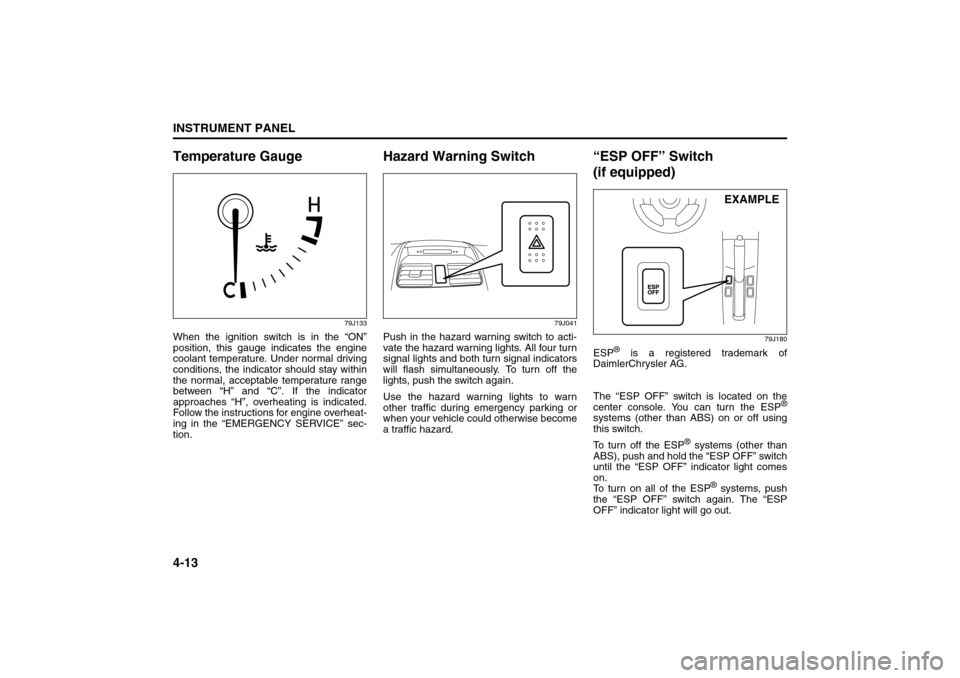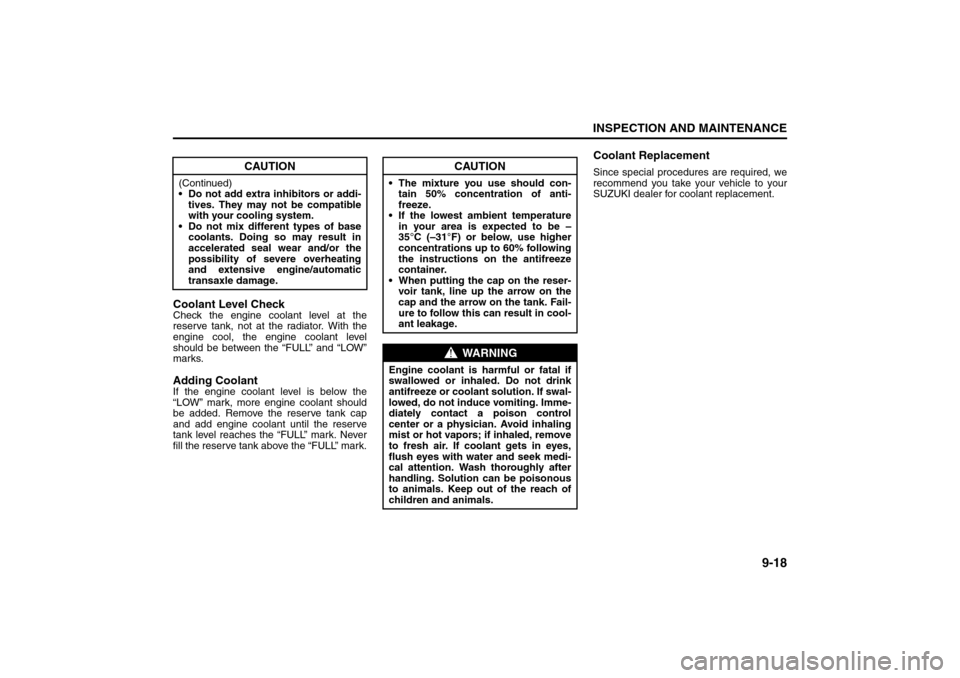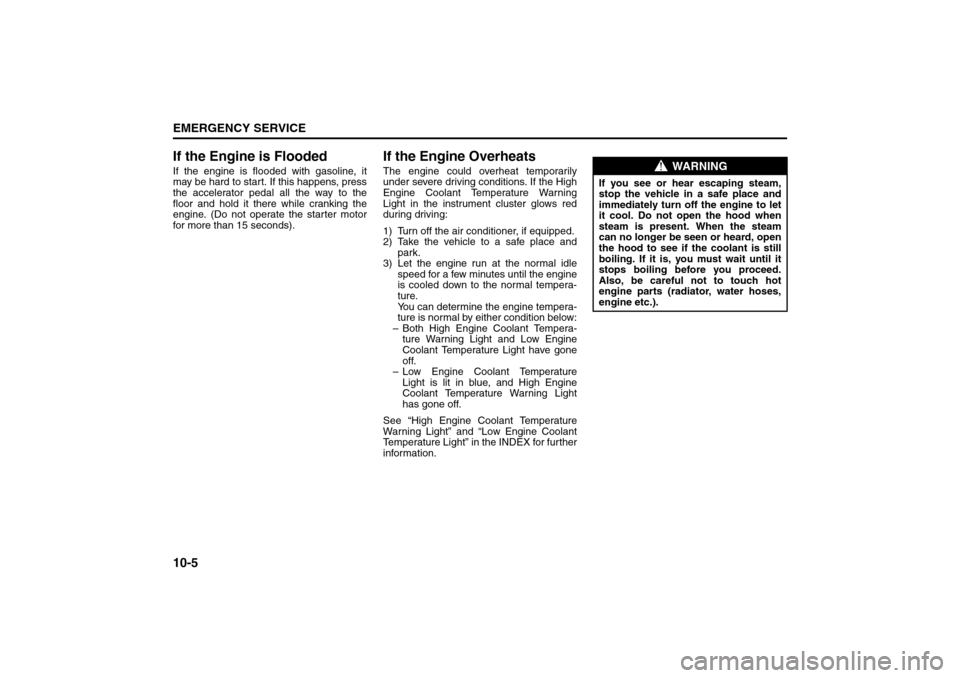2008 SUZUKI SX4 coolant temperature
[x] Cancel search: coolant temperaturePage 90 of 278

4-13INSTRUMENT PANEL
80J21-03E
Temperature Gauge
79J133
When the ignition switch is in the “ON”
position, this gauge indicates the engine
coolant temperature. Under normal driving
conditions, the indicator should stay within
the normal, acceptable temperature range
between “H” and “C”. If the indicator
approaches “H”, overheating is indicated.
Follow the instructions for engine overheat-
ing in the “EMERGENCY SERVICE” sec-
tion.
Hazard Warning Switch
79J041
Push in the hazard warning switch to acti-
vate the hazard warning lights. All four turn
signal lights and both turn signal indicators
will flash simultaneously. To turn off the
lights, push the switch again.
Use the hazard warning lights to warn
other traffic during emergency parking or
when your vehicle could otherwise become
a traffic hazard.
“ESP OFF” Switch
(if equipped)
79J180
ESP
® is a registered trademark of
DaimlerChrysler AG.
The “ESP OFF” switch is located on the
center console. You can turn the ESP
®
systems (other than ABS) on or off using
this switch.
To turn off the ESP
® systems (other than
ABS), push and hold the “ESP OFF” switch
until the “ESP OFF” indicator light comes
on.
To turn on all of the ESP
® systems, push
the “ESP OFF” switch again. The “ESP
OFF” indicator light will go out.EXAMPLE
Information Display:
Page 196 of 278

9-7INSPECTION AND MAINTENANCE
80J21-03E
Maintenance Recommended under Severe Driving ConditionsFollow this schedule if your car is mainly operated under one or more of the following conditions:
When most trips are less than 6 kilometers (4 miles)
When most trips are less than 16 kilometers (10 miles) and outside temperature remain below freezing.
Idling and/or low-speed operation in stop-and-go traffic.
Operating in dusty areas.
Schedule should also be followed if the car is used for delivery service, police, taxi or other commercial applications.
R: Replace or change
I : Inspect, clean, adjust, lubricate or replace as necessaryInterval: This interval should be judged by odometer
reading or months, whichever comes first.miles (x 1000) 3 6 9 12 15 18 21 24 27 30 33 36 39
km (x 1000) 5 101520253035404550556065
months 3 6 9 12 15 18 21 24 27 30 33 36 39ENGINE & EMISSION CONTROL
1. Drive belt
*Tension check, *adjustment, *replacement
–
–
–
–
–
–
–
–
–
I
–
–
–
*2.Valve lash (clearance) ––––––––– I –––
3.Engine oil and oil filter
R
R
R
R
R
R
R
R
R
R
R
R
R
*4. Cooling system hoses and connections–––– I –––– I –––
5.Engine coolant
–
–
–
–
–
–
–
–
–
R
–
–
–
*6. Exhaust pipes and mountings–––– I –––– I –––
*7.
EVAP canister
Replace every 250000 km (150000 miles) or 180 months
*8.Emission-related hoses & tubes –––––––––––––
9.Spark plugs
–
–
–
–
–
–
–
–
–
–
–
–
–
*10.Ignition coil (plug cap) ––––––––– I –––
*11.
Fuel tank & cap
–
–
–
–
I
–
–
–
–
I
–
–
–
12. Air cleaner filter element (paved road)IIIIIIIIIRIII
*13.
Fuel filter
Replace every 250000 km (150000 miles) or 150 months
*14. Fuel lines and connections–––– I –––– I –––
*15.
Canister air suction filter
–
–
–
–
–
–
–
–
–
–
–
–
–
Engine Oil and Filter: 1, 2
Page 207 of 278

9-18
INSPECTION AND MAINTENANCE
80J21-03E
Coolant Level CheckCheck the engine coolant level at the
reserve tank, not at the radiator. With the
engine cool, the engine coolant level
should be between the “FULL” and “LOW”
marks.Adding CoolantIf the engine coolant level is below the
“LOW” mark, more engine coolant should
be added. Remove the reserve tank cap
and add engine coolant until the reserve
tank level reaches the “FULL” mark. Never
fill the reserve tank above the “FULL” mark.
Coolant ReplacementSince special procedures are required, we
recommend you take your vehicle to your
SUZUKI dealer for coolant replacement.
CAUTION
(Continued)
Do not add extra inhibitors or addi-
tives. They may not be compatible
with your cooling system.
Do not mix different types of base
coolants. Doing so may result in
accelerated seal wear and/or the
possibility of severe overheating
and extensive engine/automatic
transaxle damage.
CAUTION
The mixture you use should con-
tain 50% concentration of anti-
freeze.
If the lowest ambient temperature
in your area is expected to be –
35°C (–31°F) or below, use higher
concentrations up to 60% following
the instructions on the antifreeze
container.
When putting the cap on the reser-
voir tank, line up the arrow on the
cap and the arrow on the tank. Fail-
ure to follow this can result in cool-
ant leakage.
WARNING
Engine coolant is harmful or fatal if
swallowed or inhaled. Do not drink
antifreeze or coolant solution. If swal-
lowed, do not induce vomiting. Imme-
diately contact a poison control
center or a physician. Avoid inhaling
mist or hot vapors; if inhaled, remove
to fresh air. If coolant gets in eyes,
flush eyes with water and seek medi-
cal attention. Wash thoroughly after
handling. Solution can be poisonous
to animals. Keep out of the reach of
children and animals.
Brakes: 6
Page 244 of 278

10-5EMERGENCY SERVICE
80J21-03E
If the Engine is FloodedIf the engine is flooded with gasoline, it
may be hard to start. If this happens, press
the accelerator pedal all the way to the
floor and hold it there while cranking the
engine. (Do not operate the starter motor
for more than 15 seconds).
If the Engine OverheatsThe engine could overheat temporarily
under severe driving conditions. If the High
Engine Coolant Temperature Warning
Light in the instrument cluster glows red
during driving:
1) Turn off the air conditioner, if equipped.
2) Take the vehicle to a safe place and
park.
3) Let the engine run at the normal idle
speed for a few minutes until the engine
is cooled down to the normal tempera-
ture.
You can determine the engine tempera-
ture is normal by either condition below:
– Both High Engine Coolant Tempera-
ture Warning Light and Low Engine
Coolant Temperature Light have gone
off.
– Low Engine Coolant Temperature
Light is lit in blue, and High Engine
Coolant Temperature Warning Light
has gone off.
See “High Engine Coolant Temperature
Warning Light” and “Low Engine Coolant
Temperature Light” in the INDEX for further
information.
WARNING
If you see or hear escaping steam,
stop the vehicle in a safe place and
immediately turn off the engine to let
it cool. Do not open the hood when
steam is present. When the steam
can no longer be seen or heard, open
the hood to see if the coolant is still
boiling. If it is, you must wait until it
stops boiling before you proceed.
Also, be careful not to touch hot
engine parts (radiator, water hoses,
engine etc.).
Jump Starting Instructions: 7
Towing a Disabled Vehicle: 6
Page 245 of 278

10-6
EMERGENCY SERVICE
80J21-03E
If the temperature indication does not
return to the normal condition:
1) Turn off the engine and check that the
water pump belt and pulleys are not
damaged or slipping. If any abnormality
is found, correct it.
2) Check the coolant level in the reservoir.
If it is found to be lower than the “LOW”
line, look for leaks at the radiator, water
pump and radiator and heater hoses. If
you locate any leaks that may have
caused the overheating, do not run the
engine until these problems have been
corrected.
3) If you do not find a leak, carefully add
coolant to the reservoir and then the
radiator, if necessary. (Refer to “Engine
Coolant” in the “INSPECTION AND
MAINTENANCE” section.)
65D614
If You Can Not Shift
Automatic Transaxle
Gearshift Lever Out of “P”
(PARK)
62J083
Vehicles with an automatic transaxle have
an electrically operated park-lock feature.
If the vehicle’s battery is discharged, or
there is some other electrical failure, the
automatic transaxle cannot be shifted out
of Park in the normal way. Jump starting
may correct the condition. If not, follow the
procedure described below. This proce-
dure will permit changing the transaxle out
of Park.
1) Be sure the parking brake is firmly
applied.
2) If the engine is running, stop the
engine.
WARNING
It is hazardous to remove the radia-
tor cap when the water temperature
is high, because scalding fluid and
steam may be blown out under
pressure. The cap should only be
taken off when the coolant temper-
ature has lowered.
To prevent personal injury, keep
hands, tools and clothing away
from the engine cooling fan and air-
conditioner fan (if equipped). These
electric fans can automatically turn
on without warning.
(1)
If the Starter Does Not Operate: 2, 9
If the Engine is Flooded: 2, 9
If the Engine Overheats: 2, 9
Page 274 of 278

15-4INDEX
80J21-03E
Periodic Maintenance Schedule ........................................... 9-3
Power Assisted Brakes ......................................................... 6-9
Power Door Locking System ................................................ 2-2
Power Mirror Control ........................................................... 2-19
Power Steering..................................................................... 9-23
Power Steering Fluid ........................................................... 9-23
Power Window Controls ..................................................... 2-16RRadio Antenna ............................................................ 4-38, 5-16
Rear Window Wiper/Washer Switch .................................... 3-8
Refill with Oil and Check for Leaks .................................... 9-13
Refilling................................................................................. 9-12
Remote Audio Controls.............................................. 3-11, 4-53
Replace the Oil Filter ........................................................... 9-13
Replacing Tires and/or Wheels .......................................... 6-18
Reporting Safety Defects .................................................... 12-4
Roof Rails or Roof Rack Anchors ...................................... 5-16SSafety Certification Label.................................................... 12-2
Seat Adjustment .................................................................. 2-19
Seat Belt Extender ............................................................... 2-38
Seat Belt Hanger .................................................................. 2-28
Seat Belt Inspection ............................................................ 2-29
Seat Belt Pretensioner System........................................... 2-39
Seat Belt Reminder .............................................................. 2-26
Seat Belts and Child Restraint Systems............................ 2-22
Selection of Coolant ............................................................ 9-17
Shoulder Anchor Height Adjuster ...................................... 2-28
Side Air Bags and Side Curtain Air Bags .......................... 2-43
Side Door Locks .................................................................... 2-1
SLIP Indicator Light ...................................................... 4-5, 6-13Snow Tires ............................................................................ 9-31
Spark Plugs .......................................................................... 9-20
SPECIFICATIONS ................................................................. 14-1
Specified Fluid...................................................................... 9-16
Specified Gear Oil ................................................................ 9-14
Specified Oil ......................................................................... 9-11
Speedometer ........................................................................ 4-11
Spot Light ............................................................................... 5-9
Stability Control System...................................................... 6-12
Starting the Engine ................................................................ 6-2
Steering Wheel ..................................................................... 9-23
Sun Visor ................................................................................ 5-8
Supplemental Restraint System (air bags) ........................ 2-40
TTachometer ........................................................................... 4-12
Tailgate.................................................................................. 2-14
Temperature Gauge ............................................................. 4-13
Theft Deterrent Light............................................................ 4-20
Thermometer ........................................................................ 4-17
Tilt Steering Lock Lever ........................................................ 3-8
Tire Chains.............................................................................. 7-3
Tire Changing Tool .............................................................. 5-13
Tire Inflation Pressure ......................................................... 9-26
Tire Inspection...................................................................... 9-27
Tire Pressure Monitoring System (TPMS) ......................... 6-14
Tire Rotation ......................................................................... 9-29
Tire Sidewall Labeling ......................................................... 9-24
Tire Size ................................................................................ 9-25
Tires....................................................................................... 9-24
Towing a Disabled Vehicle .................................................. 10-4
Towing Your Vehicle (recreational towing) ......................... 8-2